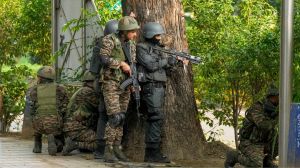‘Reinstate GO 111’: Scientists suggest best solution to save Hyderabad from ecological disasters
3 scientists prepare report on the repeal of the Government Order (GO 111). The government revoked the 26-year-old GO-111 that prevented any polluting activity, and constructions in the catchment area of Himayath Sagar and Osman Sagar reservoirs.
 The government felt the GO was redundant as the city was not dependent on the two reservoirs for its drinking water needs. (File Photo)
The government felt the GO was redundant as the city was not dependent on the two reservoirs for its drinking water needs. (File Photo) Even as Telangana continues to work out plans and proposals for the best use of about 1,32,000 acres of land that demarcated a 10-sqkm radius of two century-old reservoirs Himayath Sagar and Osman Sagar outside Hyderabad city, environmental scientists warn of unprecedented ecological damages to the city.
The land was released last year for development by revoking a 26-year-old government order ‘GO 111’.
Environmentalists and retired scientists Kalapala Babu Rao, Sagar Dhara, and B Ramalingeswara Rao Sunday released the People’s Scientific Committee’s report on ‘Repeal of GO 111’ to argue that the best choice for the government would be to reinstate the government order in the larger interest of the city.
The government felt the GO was redundant as the city was not dependent on the two reservoirs for its drinking water needs, which was one of the many reasons the two were commissioned in the 1920s by the seventh Nizam of Hyderabad Mir Osman Ali Khan.
While GO-111 prevented any polluting activity, constructions and industries, from being set up in the catchment area as well as upstream covering 84 villages, the subsequent GO-69 issued in April 2022 removed all such restrictions. Currently, the government is awaiting a report from a committee of experts constituted under GO-69 to frame guidelines for zoning and detailed regulations for the development of infrastructure. The government recently informed the High Court that it will abide by the provisions of GO-111 till the report is received.
However, the new People’s Scientific Committee’s report highlighted that the purpose of the two reservoirs as the city’s flood mitigation mechanism should not be overlooked as a repeat of the Great Musi Flood of September 1908 cannot be ruled out in the near future. More than 15,000 people died when the river water rose by 20 metres following extremely heavy rainfall of about 432 mm in less than 36 hours.
K Babu Rao said the report has looked into possible outcomes of unscientific urbanisation that is likely to happen at the lands released after the revocation of GO-111 based on peer-reviewed scientific research papers, government data collected through RTI, and fundamental principles of science. He alleged that most of the government data available are fudged and impossible to believe.
Sagar Dhara said ignoring the two reservoirs that brought water to the city by gravity and drawing drinking water from river Krishna located as far as 114 km away to Hyderabad would require a 50 MW power plant that will also emit approximately 3,10,000 tonnes of carbon dioxide annually.
“If the recent estimated social cost of carbon is applied to compute the carbon tax payable for pumping water that otherwise would have been supplied by Himayat Sagar and Osman Sagar reservoirs by gravity flow, it would entail a carbon tax of Rs 500 crore per annum,” he said.
B Ramalingeswara Rao noted that Hyderabad city’s morpho-structural zoning resembles a ‘bowl’ and destroying the two reservoirs located at a higher altitude would not only lead to the drying up of all the borewells in the city but also increase the city’s temperature levels alarmingly.
Moreover, he added, the 1,32,000 acres of land was not suitable for major constructions as it was mostly categorised as a ‘Liquefaction potential zone’, suggesting that the soil comprising silt, clay and loose soil cannot hold stable foundations.
“There is a looming threat of earthquakes in this area, like the 3.5 magnitude earthquake that occurred near Osman Sagar in 1982, posing a major risk to the entire region. The government should conduct comprehensive field studies in the GO 111 notified region before taking up any decision,” he said.
Lubna Sarwath, whose ‘Long Live Lakes’ campaign brought together the three environmental scientists to prepare a scientific report, stressed that the GO 111 was based on five scientific reports and a Supreme Court judgment of 2000, but the GO-69 that replaced the erstwhile order was justified by none. Can a Cabinet decision undo a GO that too backed by a Supreme Court order and five scientific expert reports?” she asked.
The report also suggested several suggestions besides reinstating the GO-111, one of which is recognising the two reservoirs as ‘living beings’ with rights and responsibilities as done in many parts of the world through legislation or a government resolution.
“The rights and responsibilities of the reservoirs and the catchment areas need to be defined and a mechanism for enforcing these rights and responsibilities need to be established,” said Sagar Dhara.
Rewarding farmers here for carbon sequestration, encouraging farming without chemicals, ensuring per capita state investment in social services on a par with Hyderabad residents, ordering a freeze on the current land use in this area, preventing sewage from flowing into the two lakes, desilting and strengthening of the dams, are some of the other suggestions in the report.
Lubna Sarwth said the report will be submitted to the state government, Telangana High Court and the Supreme Court of India.













